Marmalade, you either love it, or it just isn’t your cup of tea.
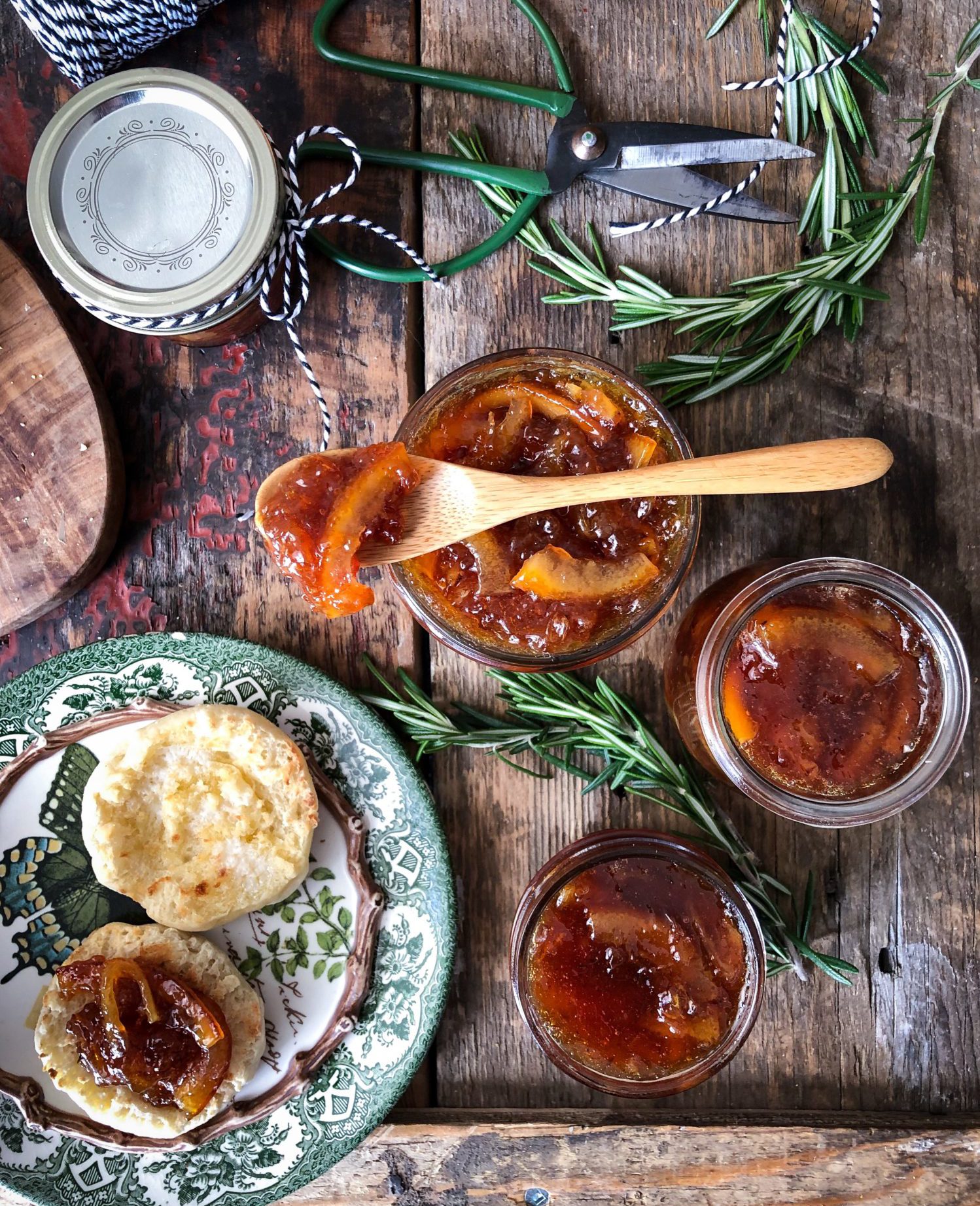 That slightly bitter tang that accompanies the sweet citrus in my most favourite of preserves is exactly why I like it. Even as a child, I found plain, sweet strawberry jam just too sweet. And kind of one-noted.
That slightly bitter tang that accompanies the sweet citrus in my most favourite of preserves is exactly why I like it. Even as a child, I found plain, sweet strawberry jam just too sweet. And kind of one-noted.
But marmalade was a totally different matter. There was the required sweetness. But it was balanced by the pithy bitterness from the peels. Even as a child, I appreciated this somewhat more adulty flavour.
We never grew up making preserves, jams or jellies in our house. Of course we canned all sorts of fruit, but whole or sliced. So making jams and preserves was something I started doing when I moved out on my own. The first one I had to get right was Plum Butter, that rich thick and slightly sweet reduction of plums and spices. It was the one jam that my mum knew that I would request when exploring the European delis where we grew up. And now I can have that velvety spread any time I’m craving it- there is usually some in the freezer if not the fridge.
And the second preserve that I had to conquer was marmalade. But I really wasn’t in the mood to do all the jars, simmering, with pectin, and then the water baths etc. I just wanted to make a few jars that I could store in the fridge and freezer, and maybe give away. So I eliminated a lot of recipes that didn’t fit the bill, till I found a few versions which were really just reductions of the fruit, sugar and water. I learned along the way, that there is enough natural pectin in the peel, that there is no reason to go out and purchase pectin to add to the simmering pot of sliced citrus, in order to get it to thicken. Besides, when the sudden craving to make jam happens, and the blood oranges or other citrus are already on the counter, the last thing I want to wonder is if there is pectin in the pantry! I kept trying a few and working through versions till I found the one that had not only ease of execution, but eliminated the need for extra pectin.
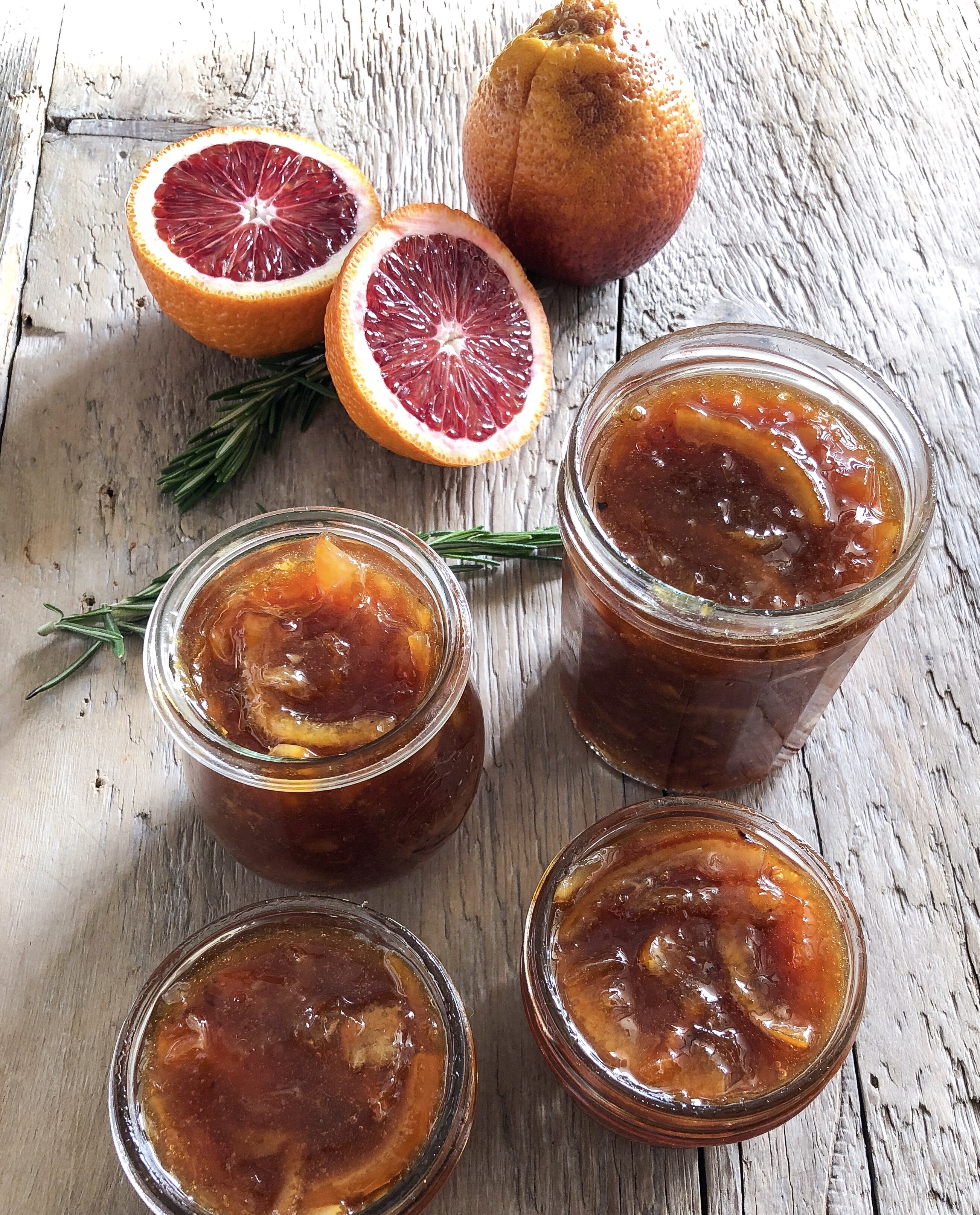
This recipe is based on a fabulous one from Rock Recipes. Not only are the ingredients ones that you will have in the kitchen come winter time, you will be pleasantly surprised at how little hands-on time is involved.
How to Make this Marmalade: This is a two step process. First, you will add all the sliced citrus into a pot, along with sugar and water. Once it has come up to a rolling boil, a lid is put on the pot, and you let it rest on the back of the stove, off the heat, overnight. This begins the process of softening the thinly sliced peel and releasing the pectin.
The next morning, the pot goes back onto the burner, and it will bubble away till the liquids reduce and the pectin is really doing it’s job. It is during this second cooking time that I add a cheesecloth bundle filled with fresh rosemary leaves. As the marmalade is bubbling away, the rosemary essential oils are being released into the liquids. I just love the added depth and slightly savoury essence that takes place when citrus and rosemary combine. This is still totally a breakfast jam.
The one thing you should really try and get is a candy thermometer. It is the most sensitive to temperature change, so it will accurately let you know when the required 220F has been reached in the reduced bubbling mass of citrus, sugar and water. But if you can’t find get hold of one, I am letting you know that the time usually needed to reach this temperature is about 15 minutes. The challenge will be in not letting it cook much longer. The longer the you cook it down, the more moisture is cooked off. It may seem just fine in the pot, but the issue happens when the marmalade is cooled down and put into the fridge. Now the pectin really starts to help thicken up the jam. If there is not enough liquid, the final result with be a very thick, stiff paste.
So I am sharing a trick here. If you’re not sure if you cooked it down too much, still let it cool down as per the directions. But don’t be in a rush to put it into individual jars. Put the pot into the fridge, and let it set up for about an hour. Take it back out and check the texture. Is it spreadable? Is it easily removed with a spoon? Or is it stiff and hard to spread? If it is the latter, put it back onto the burner. Over medium low heat, bring it up to an ever so slight simmer to help loosen everything up. Then add water, 1 tbsp at a time and stir in well, till it becomes looser. You want some looseness to the mixture. Then remove it from the heat and let it cool. Then put it in jars and store.

You can totally go the sterilized jar method etc so that these can stay in the cupboard, if you so desire. I find that it is just the two of us, so unless I am using some to bake, I can also put some of it into freezer safe containers. I don’t do a lot of actual canning, storage being a major reason. So there is no reason for me to make large batches of anything. But a few jars of something yummy is great. A jar in the fridge will easily be fine for a few months. As if it will even last that long?! And yes, tempered glass jars also freeze just fine- just don’t fill them to the very top- leave about 3/4 of an inch for expansion. But usually I just put some into tupperware, and it works fabulously.
Because of the lovely addition of the rosemary, this would be an amazing preserve to add to a cheeseboard. It would be fantastic to glaze chicken or other poultry. Add some to softened butter and blend with a fork to create a great breakfast butter to spread onto muffins, biscuits or even waffles.
And yes, you can totally switch out the citrus in this recipe. My recipe calls for three blood oranges. But if you want, why not use two large naval or Cara Cara oranges, or a combo of oranges, tangerines and even lemon? The sky is the limit. Just plan for two blood oranges to make about two cups of slices. My recipe fills about 3 8 oz jars. I am including the link to the original recipe, where you can see that the recipe makes enough for about 8 8 oz jars.
Love Jen
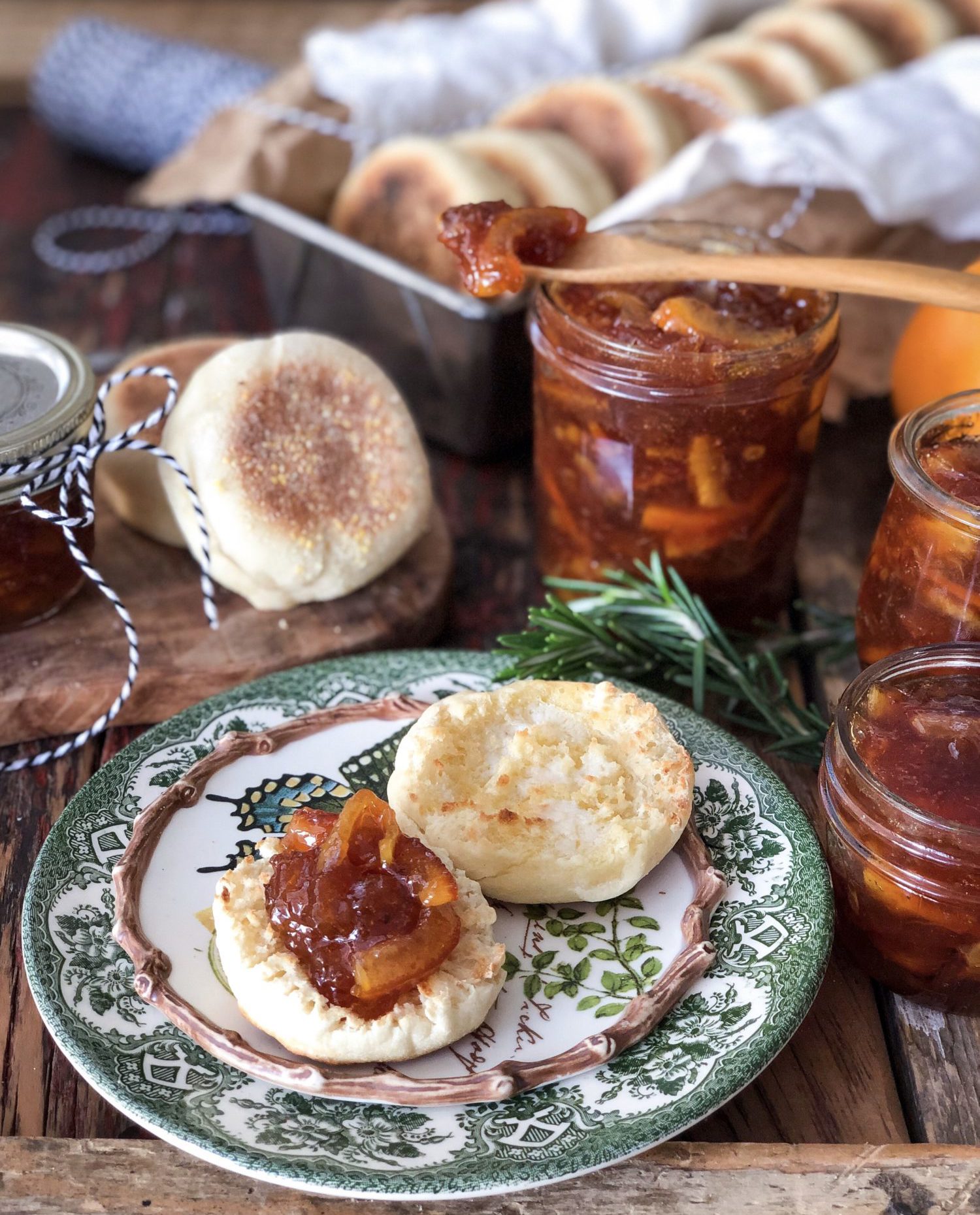
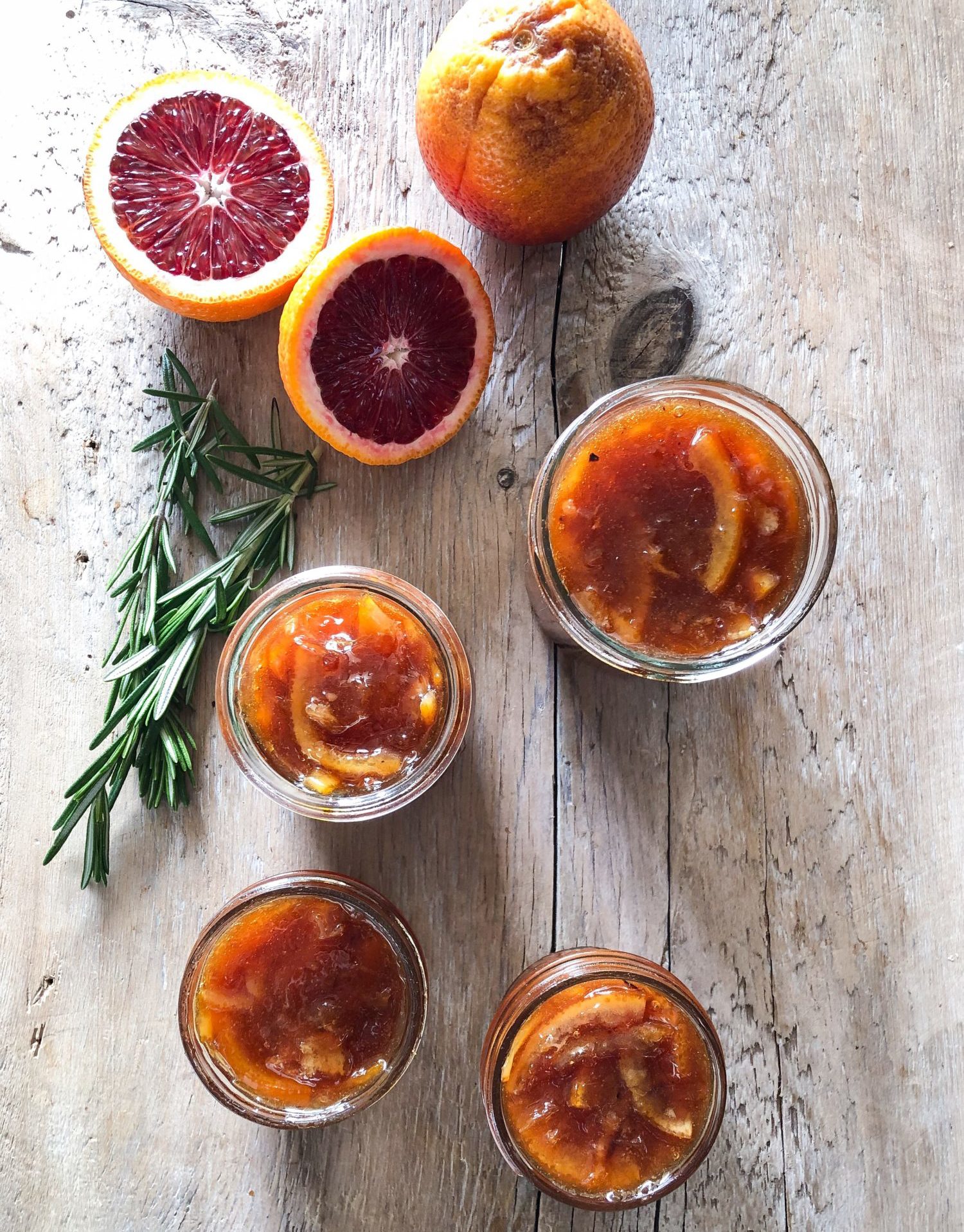
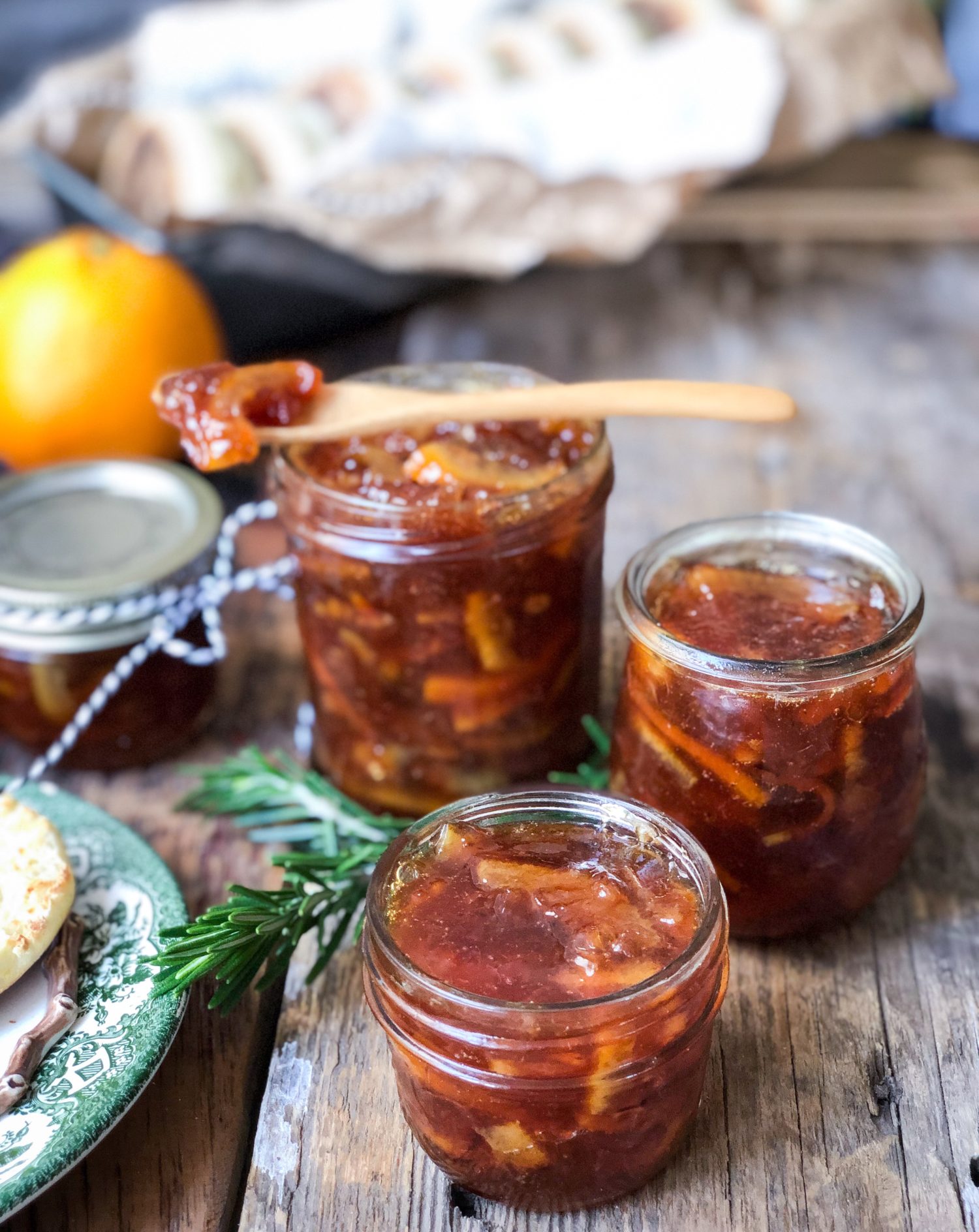
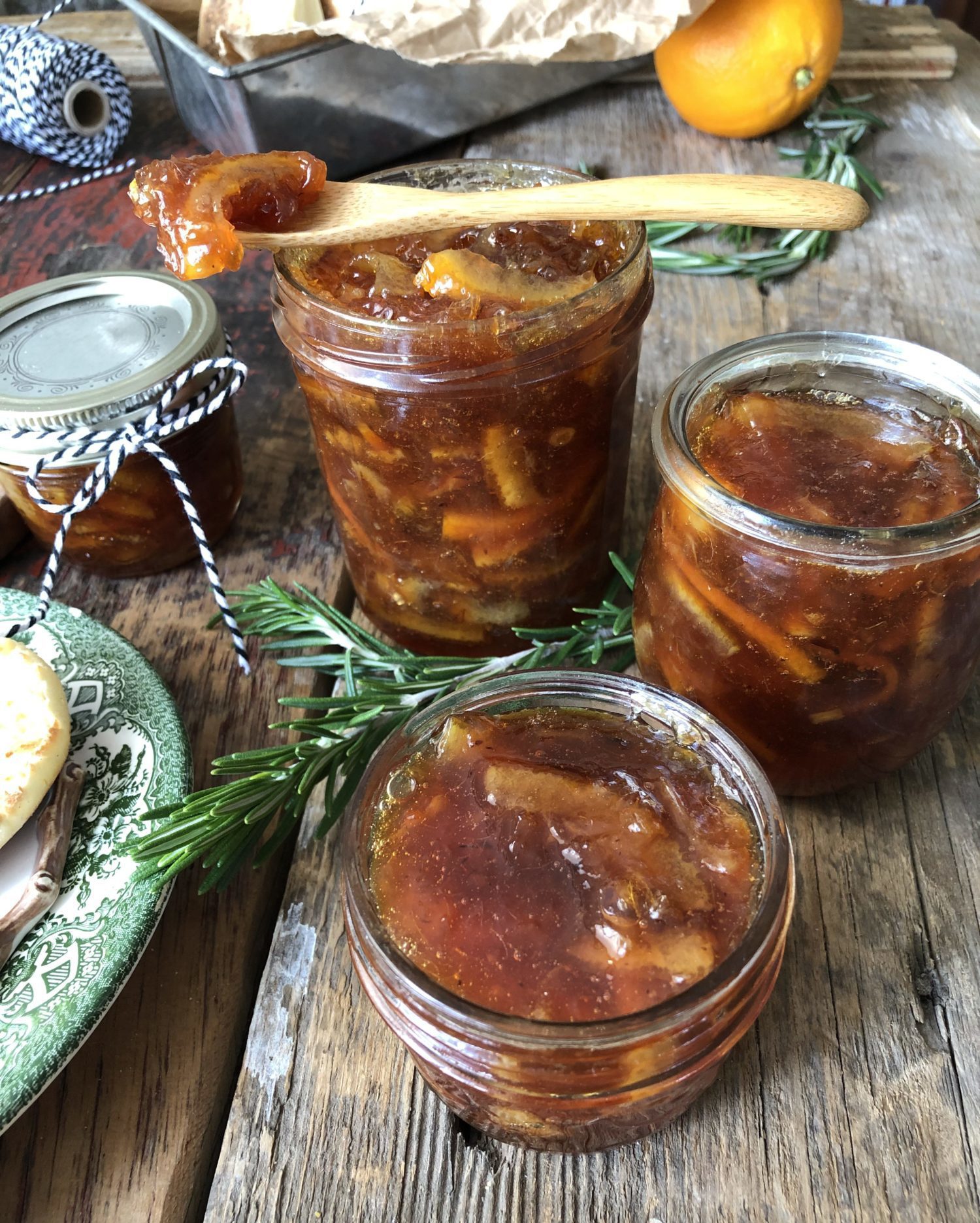
Blood Orange Rosemary Marmalade
A wonderfully savoury scented preserve, using vibrant blood oranges. This will be a great addition to your breakfast table, or cheeseboard, or even as a glaze for a roast chicken!
Ingredients
- 3 Blood Oranges two large or three medium, try not to choose ones with too thick of skins
- 2 1/2 cups water
- 2 1/2 cups sugar
- 1/4 cup packed rosemary leaves from two to three large sprigs
Instructions
Day One
-
Wash and dry the oranges, making sure the skins are nice and clean.
-
Cut each orange into quarters, then slice the quarters into very thin slices. A good knife will be your friend here. Don't rush it. Remove the end pieces that are usually just pith, no actual fruit.
-
Add the slices to the water along with the sugar in a medium pot or dutch oven. (Use only stainless steel or ceramic lined pots. The acid in the citrus fruit will react with aluminum.)
-
Slowly bring the mixture to a low bubbling boil, ensuring that the sugar is fully dissolved, then remove from the heat and cover the pot.
-
Leave the mixture in the pot at room temperature overnight.
Day Two
-
Place the rosemary leaves into the centre of a piece of cheesecloth, bring the ends together to create a little closed bundle, and tie with kitchen twine. Add this bundle to the pot.
-
Slowly bring the pot to a slow rolling boil, then reduce heat to medium low-low, to achieve a slow bubbling simmer, for about 1- 1 1/2 hours, stirring occasionally. Don't let it cook so long that too much liquid has evaporated.
-
After 1 hour, remove the rosemary bundle and increase the heat to medium. You will begin to take the temperature of the marmalade now. You want to take the mixture to between 220 and 225 degrees F on a candy thermometer. This is the temperature needed for the pectin to set. This process should take about 15 minutes, depending on the actual heat you have it set at.
-
Let cool and jar as desired. See Notes below.
Recipe Notes
You will need a piece of cheesecloth and kitchen twine for this recipe. Ideally you will also need a candy thermometer.
If you are concerned that it cooked down too long, you can test it by letting it cool in the pot and placing the pot into the fridge for an hour. Check to see the texture. Is it spreadable or has it gotten too paste-like? If so, return the pot to the stove and warm it through on medium low. Then add some water, 1 tbsp at a time and stir to loosen it up. Then you will be ready to jar it.
Options: Remove the marmalade from the heat and let it cool before adding it to sterilized mason jars and processing in a water bath to ensure a good seal on the jars as instructed by the bottle manufacturer. Store in a cool dark place. Store in jars in the fridge- it will last about two months just fine. It will also freeze fine if placed into freezer safe containers.
Link to the original recipe over at Rock Recipes!
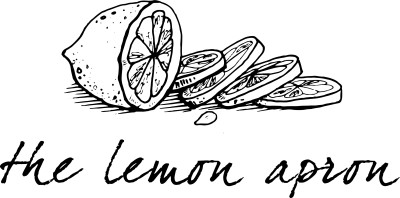
So delicious Jen!! My folks had friends over and I included it on my charcuterie and they all raved about how awesome it is!! They said it was Greek spoon sweets and I had to convince them that here we call it marmalade and although you can eat it by the spoonful – it’s usually spread on things. They loved it with the beemster!!
Oh Joanne, I’m so happy that your parents love it as much as we do! There’s something special about those of us who like that tangy sour side to marmalade! It would be brilliant on Beemster! Love Jen
Hi Jen
Curious if we wanted to gift to a family member out of state would we need to do the sterile process to mail the jam or just a sealed jar for transport? Thanks!
Hi Brandy, good question. To be on the safe side, especially since we don’t know the conditions of transport, if you want to send these as gifts, I would definitely use a correct and safe sterilizing preserving method. Most are pretty straightforward. They involve boiling the jars, and then placing the filled, sealed jars into a water bath for a boil for about 10 minutes. Use the method that you like. But it is worth it to play it safe and sterilize everything, especially after all the work of making the marmalade in the first place! Love Jen
This turned out great and was super easy to make. I doubled the recipe and got 5 half-pint jars. I think I’d prefer mine with a bit more rosemary flavor, so next time I’d ditch the cheesecloth, use a bit less rosemary, and add the fresh leaves directly to the marmalade.
Also — I only boiled it down for one hour, instead of 2 as directed, and that worked great. By 2 hours it’d be a dry, sticky mess. So keep an eye on that, everyone, and use your judgement!
Thanks for this great recipe! I’m so pleased!
Hi Amber, so happy that you like the recipe. I’m glad you added more rosemary. I find that it is one of those things, if I say to add more than I show, then for sure someone will say it was overpowering. At least this way, you know that more can be added, to satisfy your own tastebuds. I’m happy for your feedback. I’ve clarified the recipe so that it will be easier for people to not lose too much liquid. I think it is more a case of reducing the temperature under the pot, but I’ve adjusted the time on the heat as well. thanks! Love Jen
Such a delicious marmalade and sooo easy!! I live in Florida and have a plethora of citrus. Could this be done with Meyer lemons? Would I need to adjust the sugar? Super excited to put this on my Greek yogurt and toast!!
Hi Lisa, thanks! The one in my book is even better, a refined version of this one. But yes, I would think it would work great with Meyer lemons. You will need to use more, just to get the amount of pectin from the skins and membranes to thicken the marmalade. Also you may need to adjust the sugar content, since they are somewhat more tart than blood oranges. Hope this helps. Let me know how it goes, Love Jen